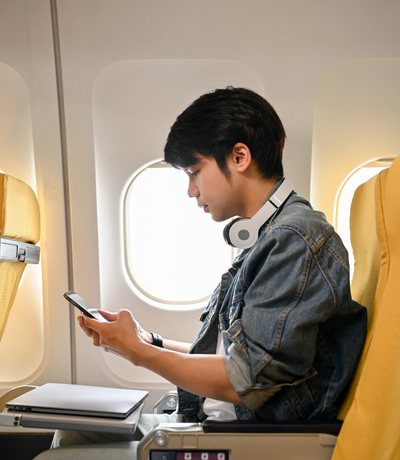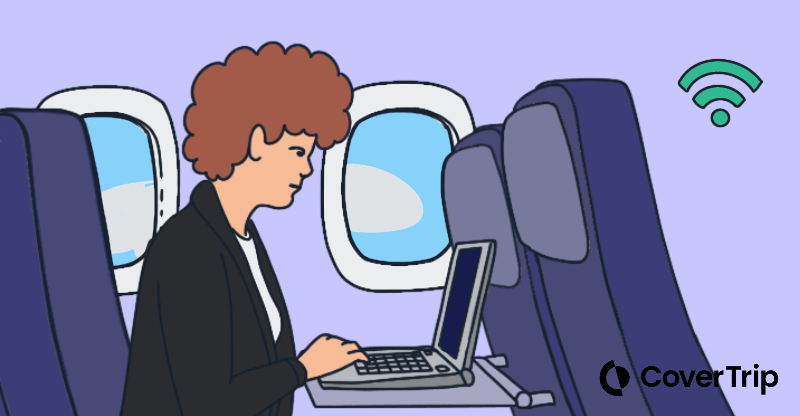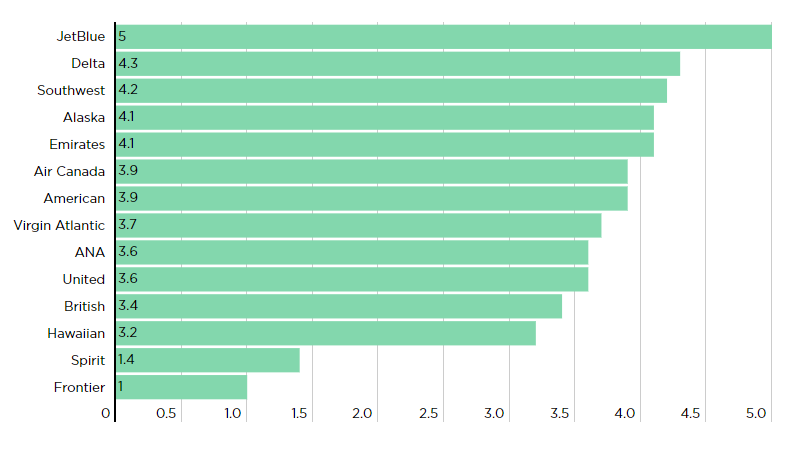Surf the skies: unlock the secrets of airplane Wi-Fi for in-flight connectivity
23 June 2023
Not long ago, it was normal to get on a flight and understand that you were basically unreachable for the duration of your journey. Nothing to do but talk to your partner or seatmate, read a good book, or take a snooze.
Then came seat-back entertainment systems which let you watch movies and TV shows.
Around a decade ago (see, not that long ago) airlines introduced Wi-Fi but it was pricey and slow; however, the surge of smart devices and demand to be online has prompted airlines to explore more advanced options to improve in-flight connectivity.
On a recent flight, however, I was disappointed with my entertainment options. I’d already downloaded movies to my tablet – or so I thought. My account showed them as downloaded, but when I tried to play them, the download was either faulty or incomplete, I never figured it out. Thanks a lot, Amazon

So, what could I have done differently? Read on to find out what your options are for Wi-Fi in the air, starting with the why?

Why don’t airplanes have free Wi-Fi yet?
According to a 2022 article from ![]() CNN Traveler, airlines have been trying to outfit planes with Wi-Fi but it’s a giant investment in time and money to offer customers the kind of high-connectivity experience they can get at say their neighborhood coffee shop for free.
CNN Traveler, airlines have been trying to outfit planes with Wi-Fi but it’s a giant investment in time and money to offer customers the kind of high-connectivity experience they can get at say their neighborhood coffee shop for free.
It turns out it’s not just to create more fee revenue, although that’s only part of the story.
The larger story is that the process to turn planes into giant, fast-moving mobile hotspots is long and involved. It will cost the airlines millions to equip each plane with high-speed internet and after that huge effort, all that hardware has to be inspected and maintained.
Airlines with great in-flight entertainment
In many cases, your options for in-flight entertainment depend on the airline. In 2022, NerdWallet analyzed 14 airlines to figure out who had the best in-flight entertainment.
Turns out that JetBlue came in first place thanks to free Wi-Fi for all guests:

Infographic credit: NerdWallet, 2022 (image linked)
Most airlines and most planes are equipped with Wi-Fi that lets you use your personal devices (phone, tablet, etc.) to watch content available on the airlines’ entertainment hub – and you don’t have to pay for the Wi-Fi.
The trick is whether you want their content or your own.
If you want to get Wi-Fi you’ll pay somewhere between $8 and $20 depending on the flight (international flights cost more), and you may not have great bandwidth. Wi-Fi prices vary widely; sometimes you pay by the hour, sometimes by the flight, and sometimes by the day.
Airlines with free texting
Did you know that your texts aren’t always getting through to recipients while you’re flying? It’s not just because airplane mode is turned on either. It may not work because you need a cellular network connection or Wi-Fi to communicate with people on the ground.
Think about that the next time you’re flying to get to someone in the hospital!
To text while you’re flying, you’ll need to use a messaging app like WhatsApp, iMessage, or WeChat. These applications don’t require a cellular network connection, but send messages through the internet instead. Of course, that means your phone needs to be connected, and depending on the airline (and all those other factors) it may cost you a fee.
Some airlines do allow texting using certain apps without a Wi-Fi connection.
Pro tip: If the airline you’re flying allows free texting through a specific app, make sure you have downloaded that texting app to your phone before takeoff.
Helpful resource: NerdWallet’s list tells you (as of May, 2023) ![]() which airlines let you text, what it costs, and which app you’ll need.
which airlines let you text, what it costs, and which app you’ll need.
Discover your options before takeoff
With every airline battling for your business, how can you find out what’s available on your flight before you take off? You may not be surprised that the answer to “Does my plane have Wi-Fi?” is “It depends.”
Don’t you just hate that answer?
The more complete answer is that it depends on some factors, including:
- The airline
- Flight length
- The route
- Type of aircraft
The best and most reliable way to understand what your in-flight options will be are to search the airline’s website for information – see this ![]() example from United. If you scroll down the page, you’ll notice this statement:
example from United. If you scroll down the page, you’ll notice this statement:

If you click that ![]() Learn more link, you’ll see a bunch of coverage maps and loads more disclaimers. Some internet coverage varies by aircraft and some by route. It’s all a jumble.
Learn more link, you’ll see a bunch of coverage maps and loads more disclaimers. Some internet coverage varies by aircraft and some by route. It’s all a jumble.
Here’s what you need to do:
- Approximately 4 days before your flight, log into the airline’s website and check your flight status.
- Type in the flight details and select the date you’re flying and your flight info will appear.
- Search through the information to find out what your Wi-Fi options are.
Frustrated yet? Me too.
Bottom line
So, here’s the bottom line on airplane Wi-Fi:
- Your best bet is to download the airline’s app to your phone before you leave and partake of the in-flight entertainment.
- If you want to watch content from the entertainment services you pay for, download it to your devices (and double-check it!), or you’ll need to pay the fee to access Wi-Fi on the plane (it may be slow or intermittent, or both).
- If you want to get some work done – read and send emails, for example – you’ll need to pay the fee to access Wi-Fi.
Pro tip: If you decide to pay for Wi-Fi, use your airline credit card because you often get a discount or cash back.
In the end, I was happy to have my e-reader all loaded up with fresh, new books. It didn’t require Wi-Fi to keep me distracted on the 6-hour flight, and I was lured into getting some much-needed sleep too.
Related topics
Damian Tysdal is the founder of CoverTrip, and is a licensed agent for travel insurance (MA 1883287). He believes travel insurance should be easier to understand, and started the first travel insurance blog in 2006.
